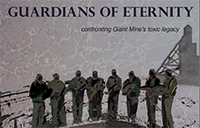The Environmental Research Group at the Robarts Centre for Canadian Studies will present its first event of the 2016-17 academic year with a screening of a documentary that explores the environmental legacies of the Giant Mine in the Northwest Territories.
 Guardians of Eternity: Confronting Giant Mine’s Toxic Legacy will screen on Monday, Sept. 19, at 2:30pm in the History Common Room, 2183 Vari Hall.
Guardians of Eternity: Confronting Giant Mine’s Toxic Legacy will screen on Monday, Sept. 19, at 2:30pm in the History Common Room, 2183 Vari Hall.
The event will welcome Professor John Sandlos from Memorial University of Newfoundland who will speak briefly about the film.
Guardians of Eternity is a full-length documentary film about the toxic legacy of the Giant Mine in Yellowknife, Northwest Territories (NWT). The Giant Mine was part of the founding infrastructure of the city of Yellowknife and can still be seen on the outskirts of town. It is located near the Yellowknives Dene First Nation communities of N’Dilo and Dettah and was built in 1949 without consent on Dene hunting and harvesting grounds.
For a number of years, highly toxic arsenic trioxide – a byproduct of the roasting process used to separate gold from the ore – spread widely from the roaster, contaminating the land around the mine. Today, the majority of the arsenic, some 237,000 tones, is buried underground in frozen chambers.
The Canadian and NWT governments are working to remediate the site and the current plan includes keeping the contaminants frozen, perhaps into eternity. The recently passed environmental assessment includes a number of measures, including an independent oversight body and a perpetual care plan, and includes the requirement that research into a more permanent solution be conducted and that the project be reviewed every 100 years.
This is one of Canada’s most contaminated sites and there is much public awareness and concern. Guardians of Eternity introduces the people who are most affected by this legacy of a gold rush and looks at the challenge of communicating the danger to future generations posed by the existence of a substance that will remain highly toxic forever.


